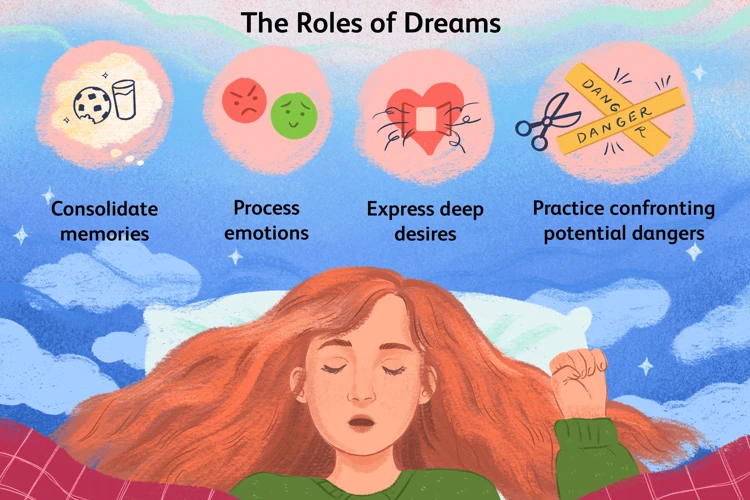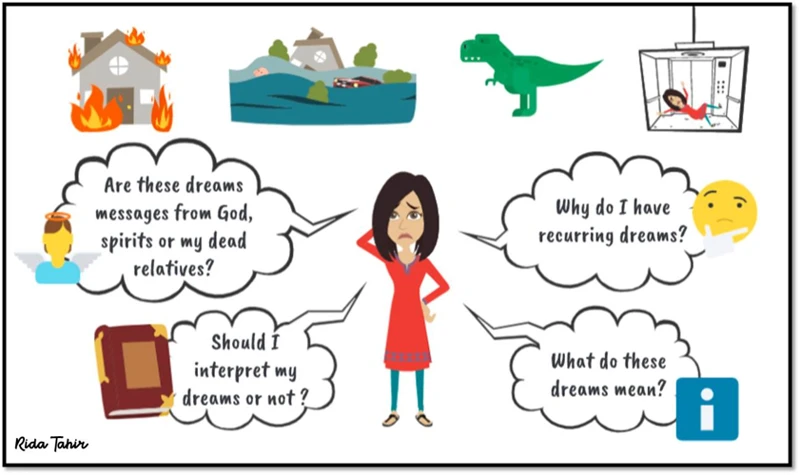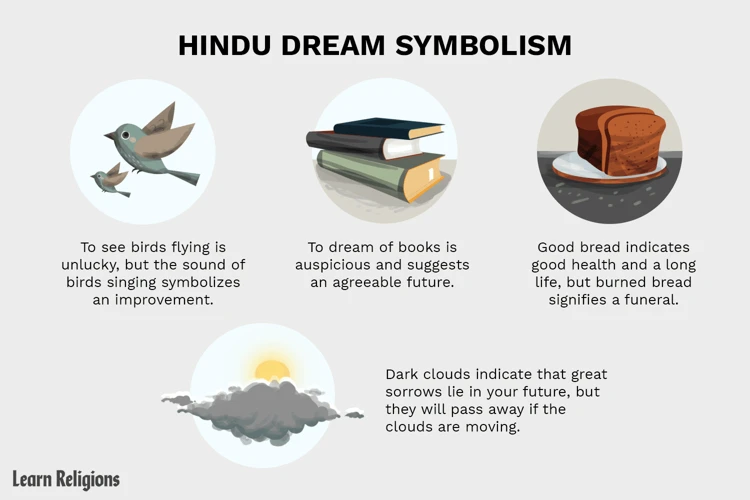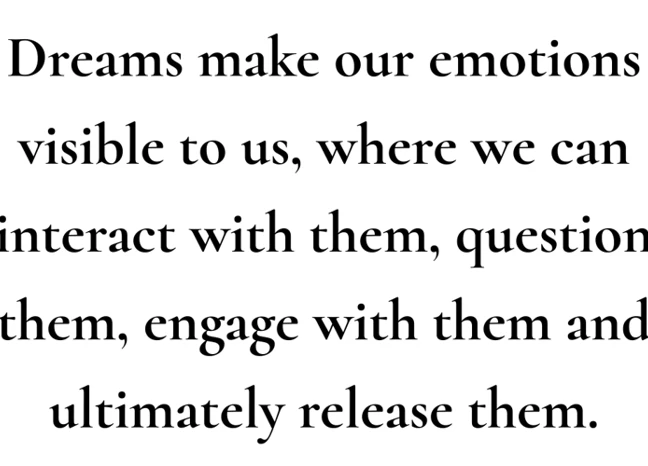Dreams have fascinated and puzzled humans for centuries, serving as a gateway to the unconscious mind. At times, dreams may seem nonsensical or random, but beneath the surface lies a hidden world of symbolism and metaphor. These metaphors hold a profound power in dream interpretation, allowing us to tap into deeper meanings and uncover truths about ourselves. In this article, we will explore the role of metaphors in dreams and how they can be deciphered step-by-step. Through understanding the language of metaphors in dreams, we can unravel the secrets of our subconscious and gain valuable insights into our emotions, desires, and fears. So, let us embark on this journey of unraveling the power of metaphor in dream interpretation.
The Role of Metaphors in Dreams

Metaphors play a crucial role in dreams, acting as symbolic language that connects our conscious and unconscious minds. They serve as a bridge between the abstract and the concrete, allowing complex emotions and ideas to be expressed in a more tangible way. In dreams, metaphors often take the form of personalized symbols that carry unique meanings to each individual. These symbols can be anything from common objects to animals, places, or even people. Metaphors in dreams provide a rich tapestry of imagery that holds deep significance. Analyzing and interpreting these metaphors can unlock hidden insights and messages from our subconscious, offering a glimpse into our deepest desires, fears, and emotions. Exploring the power of metaphor in dream interpretation can lead to profound self-discovery and personal growth.
1. Metaphors as Symbolic Language
Metaphors in dreams serve as a powerful form of symbolic language, allowing the unconscious mind to communicate messages and insights. These metaphors often present themselves in the dream imagery, presenting abstract concepts in a more concrete and relatable way. For example, dreaming about being lost in a maze can metaphorically represent feelings of confusion or being unsure about the direction in life. In this metaphor, the maze represents the complexity and uncertainty that the dreamer is experiencing. Similarly, dreaming of a broken bridge may symbolize a broken connection or a challenge in building relationships. By understanding metaphors as symbolic language, we can begin to decode the deeper meanings and messages behind our dreams. Exploring shamanic dream analysis or utilizing the Gestalt method of dream interpretation can provide further insight into the rich symbolism and language of dreams. By recognizing how metaphors function as symbolic language in dreams, we can unlock a whole new level of understanding and self-discovery.
2. Metaphors as Personalized Symbols
Metaphors in dreams act as personalized symbols, unique to each individual. These symbols can take various forms, ranging from specific objects to places, animals, or even people. The key aspect of metaphor as a personalized symbol lies in its subjective meaning. For example, a dream about a cat may symbolize independence and intuition for one person, while representing fear or unpredictability for another. This is because our experiences, beliefs, and cultural backgrounds shape the personal associations we make with different symbols. Understanding the personalized nature of metaphors in dreams requires a deep self-reflection and exploration of one’s own subconscious. Keeping a dream journal can greatly aid in this process, as it allows the dreamer to track recurring symbols and patterns over time. By analyzing and interpreting these personalized metaphors, we gain valuable insights into our innermost thoughts, emotions, and desires. This self-discovery can contribute to personal growth and offer guidance in various aspects of life. To delve deeper into the significance of dream journals in the interpretation of metaphors, refer to the article on the significance of dream journals in interpretation methods.
Common Metaphors in Dreams

Dreams are filled with a myriad of common metaphors that carry symbolic meanings. One such metaphor is water, which often represents emotions and the subconscious mind. Whether dreaming of a calm ocean or turbulent waves, the presence of water can signify the depth and intensity of our feelings. Another frequently encountered metaphor is flying, which symbolizes freedom, liberation, and the ability to rise above challenges. It is a metaphorical representation of breaking free from constraints and limitations. Falling, on the other hand, is a metaphor that reflects fear and vulnerability. It represents the loss of control or the fear of failure. Animals also serve as metaphors in dreams, with each species representing specific characteristics or qualities. For example, a snake may symbolize transformation or hidden fears, while a lion embodies strength and courage. Understanding these common metaphors in dreams is key to unraveling their meanings and gaining insights into our subconscious minds.
1. Water as Emotions
Water is a powerful metaphor commonly found in dreams, symbolizing emotions and the depths of our inner world. When water appears in dreams, it can take various forms such as oceans, rivers, lakes, or even rain. Each form and its characteristics carry unique meanings. For example, calm and serene water often represents a sense of peace and tranquility, while turbulent and stormy water may signify unresolved emotional turmoil. Additionally, the depth and clarity of the water can reflect the depth and clarity of our emotions.
1. Water as Emotions:
– Oceans and seas: They represent the vastness and depth of emotions. The calmness or roughness of the waves can reflect the state of one’s emotional stability or chaos.
– Rivers and streams: These flowing bodies of water symbolize the movement and flow of emotions. The speed and direction of the river may offer insights into the intensity and direction of one’s feelings.
– Lakes and ponds: These still bodies of water often signify emotional stagnation or a need for introspection. The clarity or murkiness of the water can hint at the clarity of our emotional state.
– Rain and tears: These forms of water in dreams are associated with cleansing, release, and healing of emotions. They can indicate the need to let go of pent-up feelings or to express emotions that have been suppressed.
It’s important to consider the context of the dream and personal associations with water when interpreting its symbolic meaning. For some individuals, water might evoke positive emotions like joy and rejuvenation, while for others, it could signify feelings of fear or vulnerability. Understanding the metaphorical significance of water in dreams requires an exploration of personal experiences, emotions, and the specific context in which the dream occurs. By delving into the metaphor of water as emotions in dream analysis, we can gain deeper insights into our emotional landscape and navigate our feelings with greater understanding and clarity.
2. Flying as Freedom
Flying is a common metaphor in dreams and is often associated with the concept of freedom. When a person dreams of flying, it represents a sense of liberation, breaking free from the constraints and limitations of everyday life. This metaphorical interpretation of flying stems from the physical experience of being able to soar through the air with ease, unencumbered by gravity. The act of flying in a dream can evoke a feeling of exhilaration and empowerment, symbolizing the desire for independence, autonomy, and the ability to rise above challenges.
In the context of dream interpretation, flying as freedom can have various levels of meaning depending on the dreamer’s personal associations and emotions. For some, it may reflect a longing for liberation from a specific situation or relationship that feels suffocating or restrictive. Flying in a dream can serve as a metaphorical representation of the dreamer’s aspiration to break free from these constraints and embrace a more unrestricted and fulfilling life.
The experience of flying in a dream can also symbolize the need for emotional or psychological freedom. It may suggest a desire to release oneself from emotional burdens, past traumas, or limiting beliefs that hold the dreamer back. Flying represents the dreamer’s yearning to soar above these challenges and embrace a lighter, more liberated state of being.
It is important to note that the interpretation of flying as freedom in a dream can vary from person to person. Cultural and personal beliefs, as well as individual experiences, can influence the specific meaning of this metaphor. When analyzing dreams involving flying, it is essential to consider the dreamer’s unique perspectives and associations with this powerful symbol.
By recognizing flying as a metaphor for freedom in dream interpretation, individuals can delve deeper into their subconscious desires for independence and personal growth. Exploring the symbolism of flying can provide valuable insights into the dreamer’s aspirations, motivations, and the actions needed to achieve a sense of freedom and empowerment in waking life.
3. Falling as Fear
In the realm of dream interpretation, the metaphor of falling often embodies the emotion of fear. When we experience the sensation of falling in a dream, it represents a loss of control or a sense of insecurity in our waking lives. The feeling of plummeting downward can trigger deep-rooted anxieties and vulnerabilities. Falling as a metaphor in dreams can manifest in various ways – from falling off a cliff to plummeting from a great height or even slipping on an icy surface. Regardless of the specific scenario, the underlying meaning remains consistent – a fear of failure, a fear of the unknown, or a fear of losing one’s grip on stability. These dreams may arise during times of uncertainty or during periods of change in our lives, serving as a reflection of our anxieties and reminding us to confront and overcome our fears. By delving into the metaphor of falling in dream interpretation, we can gain a better understanding of our fears, confront them head-on, and ultimately strive for personal growth and emotional well-being.
4. Animals as Characteristics
Animals often appear in dreams as representations of specific characteristics or qualities. Just as different animals possess distinct traits, their presence in dreams can symbolize certain aspects of our own personalities or emotions. For example:
1. Lions: Lions are associated with strength, courage, and leadership. If a lion appears in a dream, it may suggest that the dreamer possesses or needs to embrace these qualities in their waking life.
2. Dolphins: Dolphins are often seen as symbols of intelligence, playfulness, and social connection. Seeing dolphins in a dream may indicate a desire for more joy and connection in one’s life.
3. Owls: Owls are commonly associated with wisdom, intuition, and insight. Dreaming of an owl may suggest that the dreamer should pay attention to their inner guidance and trust their instincts.
4. Snakes: Snakes can represent transformation, healing, or personal growth. The presence of a snake in a dream may indicate that the dreamer is going through a period of change and needs to embrace it.
5. Butterflies: Butterflies often symbolize transformation, beauty, and growth. Seeing a butterfly in a dream may suggest that the dreamer is undergoing a positive personal transformation or that they should embrace change.
It’s important to note that the specific meaning of an animal symbol in a dream can vary depending on the dreamer’s personal associations and cultural background.
Interpreting Metaphors in Dreams

Interpreting metaphors in dreams is a fascinating process that requires careful analysis and an understanding of the dreamer’s personal associations. Each individual may have different interpretations for the same metaphor, as it is often influenced by their unique experiences and emotions. To decipher metaphors in dreams, it is essential to consider both personal and universal symbolism. Personal associations involve reflecting on specific memories, experiences, or emotions connected to the metaphor, while universal symbolism encompasses the broader cultural or archetypal meanings attached to certain symbols. Additionally, the dreamer’s emotions and the context of the dream play a crucial role in unraveling the metaphor’s hidden meaning. By piecing together these elements, dream interpreters can delve deeper into the subconscious and gain valuable insights into the dreamer’s psyche.
1. Analyzing Personal Associations
Analyzing personal associations is a key step in interpreting metaphors in dreams. This involves examining the specific symbols or metaphors present in the dream and reflecting on the personal meaning they hold for the dreamer. To effectively analyze personal associations, consider the following steps:
1. Identify the metaphor: Begin by identifying the metaphor or symbol that stands out in the dream. It could be an object, a person, or even an action.
2. Reflect on personal experiences: Once the metaphor is identified, reflect on any personal experiences or memories associated with it. Consider the emotions, thoughts, or events connected to that particular symbol in your own life.
3. Explore emotional responses: Pay attention to the emotions evoked by the metaphor in the dream. Ask yourself how you feel when you encounter this symbol and what it represents to you personally.
4. Consider cultural and societal influences: While personal associations are important, it is also essential to consider cultural and societal influences that might shape your interpretation of the metaphor. Different cultures may attach different meanings to certain symbols, so it is helpful to explore the broader cultural context as well.
5. Connect the dots: As you analyze personal associations, look for patterns or connections between the metaphor in the dream and your waking life. Are there any similarities or parallels that emerge? These connections can provide valuable insights into your subconscious thoughts and feelings.
By analyzing personal associations, you can unravel the intricate layers of meaning within metaphors in dreams, gaining a deeper understanding of yourself and the messages your subconscious is trying to convey. It is a deeply introspective process that allows you to tap into your own unique experiences and emotions, enhancing your ability to interpret the metaphors in your dreams accurately.
2. Identifying Universal Symbolism
Identifying universal symbolism in dreams is a key step in unraveling the meanings behind metaphors. Universal symbols are archetypal in nature, transcending cultural boundaries and carrying collective significance. They tap into shared human experiences and emotions, making them powerful tools for dream interpretation. To identify universal symbolism, it’s important to consider common associations and cultural references that are widely recognized. For example, water often symbolizes emotions and the subconscious mind, while flying represents freedom and liberation. Other universal symbols may include certain animals like snakes representing transformation or lions symbolizing courage and strength. By understanding these shared symbolisms, we can gain deeper insights into the messages our dreams are conveying. Keeping a dream dictionary or reference guide can be helpful in recognizing and interpreting these universal symbols. However, it’s essential to remember that personal associations and experiences should also be taken into account, as they can influence the individual interpretation of these symbols. Embracing the exploration of universal symbolism in dreams allows us to tap into the collective human unconscious and discover hidden layers of meaning within our own dreams.
3. Considering the Dreamer’s Emotions and Context
When interpreting metaphors in dreams, it is essential to consider the dreamer’s emotions and context. Emotions play a significant role in dreams, as they often manifest symbolically through metaphors. For example, a dream involving water may represent emotions such as calmness, serenity, or even turmoil, depending on the dreamer’s emotional state. Understanding the dreamer’s emotions can provide valuable insights into the meaning behind the metaphor.
Additionally, the context of the dream is crucial in interpreting metaphors. Every dream occurs within a specific narrative or scenario, and this context can shed light on the metaphors present. For instance, if a dream involves flying, the meaning can differ depending on the surrounding circumstances. Flying in a joyful and exhilarating context may symbolize a sense of freedom and empowerment. Conversely, flying in a fearful or chaotic context may represent a desire to escape or feelings of insecurity. By considering the dreamer’s emotions and the specific context of the dream, a more accurate interpretation of the metaphors can be achieved.
To effectively analyze the dreamer’s emotions and context, it can be helpful to keep a dream journal. This journal allows the dreamer to record their dreams along with the accompanying emotions and any notable details about the dream’s setting or events. Reflecting on these entries over time can reveal patterns and connections between emotions, context, and metaphors, aiding in the interpretation process.
Seeking professional guidance from dream analysts or therapists specializing in dream interpretation can provide valuable insights. These experts can help unpack the rich symbolism present in the metaphors, taking into account the dreamer’s personal history, experiences, and psychological background. Their expertise can offer a deeper understanding of the metaphors and their significance in relation to the dreamer’s emotions and context.
Considering the dreamer’s emotions and context is essential when unraveling the power of metaphors in dream interpretation. By recognizing and analyzing these factors, a comprehensive and personalized understanding of the dream’s message can be achieved, leading to self-discovery, personal growth, and a deeper connection with the unconscious mind.
Unveiling Hidden Meanings

Unveiling hidden meanings in dreams requires us to look beyond the literal interpretation of the dream events. Dreams are often filled with symbolism and metaphorical representations of our subconscious thoughts and emotions. By delving deeper into these metaphors, we can uncover hidden desires, fears, and unresolved conflicts that may be influencing our waking lives. Exploring the subconscious desires and fears that lie beneath the surface can provide valuable insight and guidance for personal growth and self-understanding. It is essential to approach dream interpretation with an open mind and a willingness to explore the deeper layers of meaning. By embracing the perplexity of dreams and allowing ourselves to delve into the hidden meanings, we can embark on a transformative journey of self-discovery.
1. Looking Beyond the Literal
When interpreting dreams, it is essential to look beyond the literal meaning of the dream elements or events. Dreams are filled with symbolism, and taking them at face value may result in missing the deeper messages and insights they hold. To truly understand the metaphorical language of dreams, it is important to delve into the symbolic meanings and associations attached to the dream’s elements. For example, if a dream features a snake, it is crucial not to interpret it as a literal reptile but rather explore the broader symbolism associated with snakes, such as transformation, hidden wisdom, or even deceit. By looking beyond the literal representation, we can unlock the metaphorical significance and uncover the underlying emotions, desires, or conflicts depicted in the dream. This approach allows for a more profound and nuanced interpretation, enabling individuals to gain a deeper understanding of themselves and their subconscious mind. By acknowledging and appreciating the metaphorical nature of dreams, we can tap into their power and utilize them as a tool for introspection and personal growth.
2. Exploring Subconscious Desires and Fears
Exploring subconscious desires and fears is a crucial aspect of dream interpretation, especially when it comes to analyzing metaphors within dreams. Dreams often provide a safe space for our unconscious mind to express hidden desires, unresolved conflicts, and deep-seated fears. Metaphors in dreams can serve as powerful gateways to these hidden aspects of ourselves. They can represent our secret desires, longings, and aspirations that may be buried beneath our conscious awareness. By delving into the metaphorical language of our dreams, we can uncover these hidden desires and fears, bringing them to the surface for examination and understanding. For example, a dream featuring a locked door may metaphorically symbolize a fear of the unknown or a desire for privacy and protection. Similarly, a dream about flying might represent a yearning for freedom or a sense of empowerment. The interpretation of metaphors in dreams requires careful analysis and introspection, as well as a willingness to explore the depths of our own psyche. By embracing this process, we can gain valuable insights into our subconscious desires and fears, ultimately leading to personal growth and self-discovery.
Practical Tips for Metaphor Interpretation
When it comes to interpreting metaphors in dreams, there are practical tips that can help unravel their meanings. Keeping a dream journal is an invaluable tool, as it allows the dreamer to record their dreams immediately upon awakening, capturing as much detail as possible. Reflecting on personal experiences can also provide insights into the symbolism within the dream, as past events or emotions may be influencing the metaphors. Seeking professional guidance from dream experts, such as those who specialize in shamanic dream analysis or the Gestalt method, can provide deeper understanding and interpretation. By combining these practical tips, dreamers can gain a better understanding of the metaphors in their dreams and use them as a powerful tool for self-reflection and personal growth.
1. Keeping a Dream Journal
Keeping a dream journal is a valuable practice when it comes to metaphor interpretation in dreams. By recording your dreams in a journal, you create a tangible record of your dream experiences, allowing you to revisit and analyze them later. When writing in your dream journal, be sure to include as many details as possible. Describe the setting, the people or objects present, and any emotions or sensations you felt during the dream. Pay special attention to any metaphors that appeared in your dreams and note them down prominently. This will help you identify recurring themes, symbols, and metaphors that may hold deeper meanings for you. Regularly reviewing your dream journal can reveal patterns and connections between dreams, providing insight into your subconscious mind. Additionally, keeping a dream journal can improve your dream recall over time, making it easier to remember and interpret your dreams in the future. Embrace the practice of keeping a dream journal and unlock the power of metaphor in your dream interpretation journey.
2. Reflecting on Personal Experiences
Reflecting on personal experiences is an essential step in interpreting metaphors in dreams. Each person carries a unique set of memories, emotions, and life events that shape their perspective. When confronted with a metaphor in a dream, it is important to look inward and consider how it relates to one’s own personal experiences. By reflecting on past events and the emotions associated with them, one can gain valuable insights into the meaning behind the metaphor. For example, if a dream contains a metaphor involving a beach, an individual may reflect on their own experiences and emotions related to the beach – perhaps it was a place of relaxation, a site of cherished memories, or a source of fear due to a past incident with water. By examining and connecting the emotions and personal experiences associated with the metaphor, a deeper understanding of its significance can be reached. Reflecting on personal experiences allows for a more nuanced and personalized interpretation of metaphors in dreams, making the interpretation process richer and more meaningful.
3. Seeking Professional Guidance
Seeking professional guidance for dream interpretation can be beneficial, especially when dealing with complex or recurring dreams. A trained dream analyst or therapist can provide valuable insights and help navigate the intricate layers of metaphor and symbolism within dreams. Here are some reasons why seeking professional guidance can be valuable:
- Expertise: Dream analysts and therapists have in-depth knowledge and expertise in dream symbolism and interpretation. They understand the intricate nuances of metaphors and can help unravel their meanings within the context of an individual’s personal experiences and emotions.
- Objective Perspective: Consulting a professional provides an objective perspective on dream analysis. They have the necessary distance from our personal biases and can offer alternative interpretations and insights that we may not have considered.
- Guided Exploration: Professional guidance allows for a structured and guided exploration of dreams. Dream analysts may use various techniques such as active imagination, dream reenactments, or Gestalt therapy to facilitate a deeper understanding of the symbolic messages within dreams.
- Validation and Support: Sharing dreams with a professional provides a safe and non-judgmental space to express fears, emotions, and desires. They can offer validation and support, helping individuals gain clarity and confidence in their interpretation of metaphors.
While seeking professional guidance can be immensely helpful, it is important to choose a reputable and experienced dream analyst or therapist who specializes in dream interpretation. With their guidance, individuals can delve into the profound meanings of metaphors in their dreams and gain deeper insights into their subconscious mind.
Conclusion
In conclusion, the power of metaphor in dream interpretation cannot be overstated. Dreams provide a unique window into our subconscious, and metaphors serve as the language that unlocks this window. By understanding and analyzing the metaphors present in our dreams, we can gain invaluable insights into our emotions, desires, and fears. Metaphors in dreams allow for a deeper level of self-reflection and self-discovery, helping us uncover hidden meanings and messages that may be eluding us in our waking lives. It is important to approach dream interpretation with an open mind, allowing the metaphors to guide us towards a greater understanding of ourselves. Keeping a dream journal, reflecting on personal experiences, and seeking professional guidance are practical tips that can enhance our ability to interpret metaphors in dreams. By embracing the power of metaphor in dream interpretation, we embark on a transformative journey of self-discovery and personal growth. So, next time you find yourself pondering the meaning behind a dream, remember to delve into the metaphors and unravel the rich tapestry of symbolism that lies within.
Frequently Asked Questions
1. What is the significance of metaphors in dream interpretation?
The significance of metaphors in dream interpretation lies in their ability to convey complex emotions and ideas in a more tangible and understandable way. Metaphors serve as a bridge between the conscious and unconscious mind, allowing us to tap into deeper meanings and gain insights into our subconscious desires, fears, and emotions.
2. How do metaphors act as symbolic language in dreams?
Metaphors act as symbolic language in dreams by representing abstract concepts or emotions through concrete and relatable images. They provide a way for our unconscious mind to communicate with us using symbols and metaphors that may hold personal or universal meanings.
3. Can metaphors in dreams have personalized meanings?
Yes, metaphors in dreams can have personalized meanings. While some metaphors may have universal symbolism, others can be specific to an individual’s personal experiences, beliefs, and associations. It is important to consider the context and personal significance of a metaphor when interpreting its meaning in a dream.
4. What is the metaphorical meaning of water in dreams?
Water in dreams often represents emotions and the subconscious mind. The state of the water, whether calm, turbulent, or stagnant, can provide insights into the dreamer’s emotional state. It can also symbolize purification, rejuvenation, or the ebb and flow of life.
5. Why is flying often interpreted as a metaphor for freedom in dreams?
Flying in dreams is commonly associated with a sense of freedom and liberation. It represents the ability to rise above limitations, explore new horizons, and gain a broader perspective. Flying can symbolize a desire for independence or a need to escape from restrictive situations.
6. What does it mean when we dream about falling?
Dreaming about falling is often associated with feelings of insecurity, vulnerability, or fear of failure. It can symbolize a lack of control or a sense of being overwhelmed in certain aspects of life. Falling in dreams may also indicate a need to let go of something or a fear of losing control.
7. Why do animals frequently appear as metaphors in dreams?
Animals in dreams often represent different characteristics or qualities. For example, a lion might symbolize courage and strength, while a snake could represent transformation or hidden fears. Animals as metaphors in dreams help us tap into our instincts, emotions, and subconscious desires.
8. How can personal associations help in analyzing metaphors in dreams?
Personal associations play a crucial role in understanding metaphors in dreams. By reflecting on the dreamer’s personal experiences, memories, and beliefs associated with a specific metaphor, deeper meanings and connections can be revealed. These associations provide valuable insights into the dreamer’s unique interpretation of the metaphor.
9. Is there any universal symbolism associated with metaphors in dreams?
Yes, some metaphors in dreams have universal symbolism that transcends individual experiences. For example, dreaming about a snake may symbolize transformation or hidden fears, which is commonly recognized across different cultures and belief systems. It is important to consider both personal associations and universal symbolism when interpreting metaphors in dreams.
10. How can dream journals aid in metaphor interpretation?
Keeping a dream journal can greatly aid in metaphor interpretation. By recording and reflecting on your dreams regularly, you can identify patterns, recurring metaphors, and emotions associated with certain symbols. Dream journals help in building a personalized language of metaphors and provide a valuable resource for self-reflection and deeper dream analysis.








